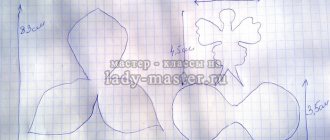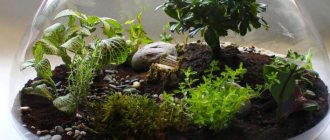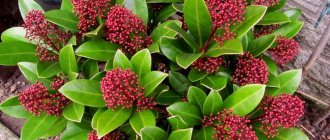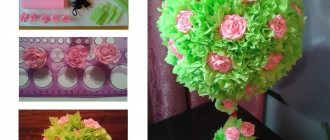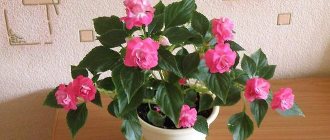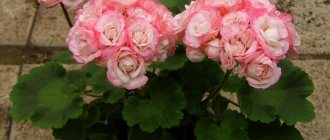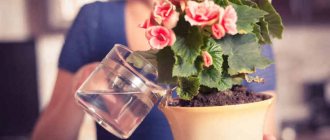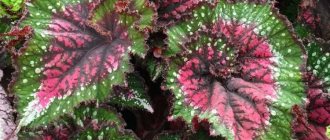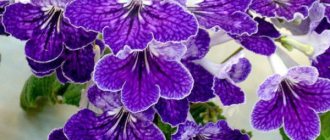Creepers are a favorite decorative material of florists. They decorate gazebos, decorate walls, and complement flower arrangements. One of them is hedera helix, a representative of the Araliaceae family.
Hedera helix is an evergreen vine. Homeland - Africa, southern Asia, southern Europe, Crimea. There its lashes reach 80 m. Thin and flexible, they wrap around supports: columns, balconies, fences. To do this, microscopic suckers and additional aerial roots on the stems are used.
Ivy hedera helix
Decorative properties are in the leaves. They are leathery and shiny. The color is dark green, which is why the plant is considered shade-loving. But the color of the leaves can be spotted and whitish. These varieties require more sun.
On vines that do not bear fruit, the leaves are 3- and 5-lobed. Those that bloom and bear fruit are ovoid or heart-shaped, without points.
You can grow ivy hedera mix at home. The poisonous properties of its berries are known. But they do not form on all types of common ivy, only on flowering varieties. But the hedera flower is inconspicuous - it is not favored by home gardeners. Therefore, to prevent the berries from ripening, the flowers are simply cut off.
For reference: in apartments, vines of this type grow 8-15 m in length. They beautifully wrap around partitions and curly stands.
Features of home care
Picture 2 Hedera helix mix.
Liana hedera requires careful care at home, in compliance with agrotechnical standards:
- Temperature. Liana doesn't like the heat. When it is above +20°C outside, the room is ventilated. The hedera indoor plant is not afraid of drafts and temperature changes.
- Lighting. The culture is shade-loving and grows well away from windows. Variegated varieties require a lot of light. But not a single type of plant can tolerate direct sunlight.
- Watering. Not a lot. Moisten when the soil has dried by 5-7 cm. In winter, the amount of moisture is reduced. In summer they water 2 times a week, in winter 1 time. Do not water at night because the water stagnates in the soil. Hedera tolerates drought better than overwatering - this is important for all lovers of indoor plants to know.
- Humidity. In winter, when the air is dried by heating, and in summer, the vine is sprayed. Use settled water. Humidity is kept within 35-40%. Twice a month, take a warm shower and wash off the dust from the leaves.
- The soil chosen is light and nutritious. Composition: turf and deciduous soil, peat, sand.
- Feeding. Mineral fertilizers are used: in the summer 2 times a month, in the winter they are reduced to once. Nitrogenous fertilizers in the spring, complex fertilizers in the summer, potassium compounds in the winter.
Virulence
The fruits of the plant cause a severe allergic reaction. Dizziness, nausea, and intestinal disorders appear. Berries cannot be eaten.
But the leaves and stems are medicinal and are used in folk medicine. Greens absorb staphylococci and influenza viruses.
Myths and superstitions
What is this flower famous for? There are many myths and superstitions associated with home ivy. Here are some of them:
- In folk medicine, ivy is used to treat rheumatism, gout, cough, headaches and other ailments. This is true, but how effective drugs with this component are is unknown.
- Ivy is poisonous. This is true. All parts of the plant are poisonous, but the berries are especially dangerous. Therefore, if home ivy somehow miraculously blooms, all the buds will have to be cut off.
- Ivy is called a “husband’s mansion” - if ivy grows at home, men will not live in it. This is a superstition, and everyone decides for themselves whether to believe in such a sign or not. But in ancient Rome, young patrician women believed that ivy contributed to a successful marriage.
Trimming
Pruning is a must for care. In spring, the vine is rejuvenated. The lashes are cut to 1/3 of the length, and the side shoots are shortened.
Golden scindapsus - home care
This is done so that the plant produces additional shoots and bushes. As a result, the ivy becomes dense. Then it is used as a basis in flower arrangements. When the branches are not given support and are planted in hanging flowerpots, the hedera becomes hanging.
For reference: cut branches can be stored for propagation, but you need to select the healthiest parts possible.
Hedera ampelous
Difficulties in growing
Diseases
Errors in care can lead to diseases in the hedera. If the pot of ivy is on the windowsill, then you should take some precautions:
- In frosty weather, if the window freezes over, do not allow the leaves to touch the frozen glass. This leads to burns that will not go away.
- In winter, you should be careful with watering, as high humidity and exposure to cold can lead to hypothermia of the roots.
Ivy can also be affected by fungus. This will be indicated by brown spots on the leaves. If there are only a few diseased parts, they need to be cut off. The fungus usually affects the plant when there is excess moisture, excessive watering or poor ventilation of the room.
Ivy leaves affected by fungus
If the hedera leaves dry, turn brown or fall off, this indicates an excessively high temperature in the room - 30°C or more.
Drying leaves can also be a symptom of lack of light. More often, variegated varieties suffer from this.
If the leaves begin to dry out and crumble, then you must first check the soil - if it is completely dry, then you should increase watering. If the soil is wet, most likely the plant does not have enough light. Then you should move the ivy to a lighted place or install an artificial light source.
Small or sparse leaves, as well as shoots reaching towards the light source, are also signs of insufficient lighting. At the same time, the colors of varieties with variegated foliage fade.
Pests
Ivy can be attacked by different types of parasites:
- scale insects;
- whiteflies;
- ticks.
The first two pests usually attack ivy when planted in contaminated soil or if there were already parasites on a nearby plant.
Different types of mites can attack hedera for unknown reasons. Signs of infection are:
- drying of leaves;
- the color becomes silver-gray instead of green;
- when infected with a broad or cyclamen mite, the tops of the shoots suffer - the leaves become wrinkled and then curl.
Getting rid of ticks will require a lot of effort:
- To begin with, you should try to overcome the parasite with a hot shower. Ivy tolerates exposure to warm water up to 55°C.
- Another option is to dip the foliage in a solution of acaricide.
- Rinse the plant in insecticide mixed with water and 1 tsp. soap solution. You can prepare the product in a bucket, and then lower the crown of the plant into it, tilting the pot. You should hold the ivy in the liquid for half a minute. The plant is then removed from the bucket and left to dry for 30 minutes. The procedure is repeated a second time. After this, the ivy is rinsed with clean water, and soil is added to the pot instead of the spilled soil.
Warm shower for ivy
Less commonly, hedera is affected by aphids. The same soap solution will help get rid of it.
A climbing hedera will decorate any greenhouse or apartment with proper care. The abundance of varieties of this plant will allow you to choose a “green friend” even for the most capricious gardener.
marked , ,
Your opinion is very important to us. Please rate the article: rated 1 , rating: 5.00 out of 5
See also related articles
Stephanotis: home care, reproduction
Eschynanthus: home care, photo
Abutilon "Indoor maple": care at home
Bacopa ampelous: planting and care, photo
Scindapsus: home care
Dichondra “Emerald Falls”: growing from seeds at home
Philodendron: home care, photos, types
Epistation: care at home
Columnea: care at home, photo
Fatshedera: care at home
Cissus: care and reproduction at home
Campanula: home care after purchase and transplantation
Add a comment Cancel reply
You must be logged in to post a comment.
✿ Alphabetical index
✿ Categories
- Houseplants
- Bromeliads
- Decorative foliage
- Trees and shrubs
- Orchids
- Succulents
- Blooming
- Perennial
✿ Popular articles
- How to grow chestnut from a nut at home in a pot
- Clematis: care and cultivation in the garden
- How to grow lemon from a seed at home with fruits: step by step
- Campanula: home care after purchase and transplantation
- How to grow pomegranate from seeds at home to produce fruits
- Decembrist flower: care at home, how to water correctly
✿ Latest comments
- Lyudmila on How to grow a lemon from a seed at home with fruits: step by step
- Tatyana on Tillandsia Anita: care at home
- LOVE for the entry Tulips: care and cultivation in the garden
Copyright © 2018-2021 GARDENER'S BOOK.
0+ By using bookgardener.ru you accept the terms of the USER AGREEMENT. Copyright for the posted materials belongs to the editors of the online magazine. When reprinting and using materials, an active hyperlink to BookGardener.ru is required
Reproduction
Bouvardia flower: home care and methods of propagation
Propagated in different ways:
- Cuttings. The apical shoots are cut and placed in water. A growth stimulator is added. You need to change the water and keep it there until roots appear. Then they are transplanted into the ground.
- Medium stem cuttings. To do this, cut a twig with 8-10 leaves from the middle of the vine. Make a groove in the sand, lay the cutting so that the leaves are on the outside, then water it. On day 10-12, roots will appear. The cuttings are dug up and cut, leaving a root and a leaf on each fragment. Planted in pots.
- By layering. A healthy stem is placed in a groove and sprinkled so that the top remains outside. When the roots appear, the cuttings are cut off from the mother bush.
- Seeds. They are collected or purchased. Sow on moist, compacted soil. Cover with glass. When sprouts appear, they are transplanted. It is difficult to care for them, the method is not rational.
Hedera - care and microclimate
Violating the growing rules will destroy the flower.
Hedera helix - what an ivy plant looks like
During the warm season, I plant it comfortably at home at a temperature of 19-22°C. The heat doesn't suit him. With the onset of summer, the plant is taken out to the loggia or balcony, where it is cooler.
Note. Hedera winters well in an apartment at a temperature not lower than +11°C. The flower is resilient to drafts, which is why the owners choose a place for it next to the door to the loggia.
Possible problems
The plant is little susceptible to disease. But pests may appear: aphids, mites, mealybugs. When they appear, hedera is treated with store-bought fungicides.
Other problems:
- brown dry edges of leaves - too hot;
- small leaves - not enough light;
- leaves lose color - cramped pot, not enough light;
- growth has slowed down - dry air.
Hedera erecta
Watering and air humidity
Common indoor variegated ivy flower
In the cold season, indoor ivy is watered once every 7 days, and in the warm season - twice a week. The flower is uncomfortable if there is insufficient air humidity in the room.
The plant is often sprayed and doused in the shower
Often a tray with water or wet expanded clay is placed under the flower pot.
Kinds
Hedera has 15 varieties of ivy for indoor cultivation.
Common varieties:
- An interesting plant is Hedera Erecta, an upright plant. Evergreen crop, reaches 90 cm in height. Frost-resistant, grows in pots or as an ornamental ground cover plant. Illumination - partial shade. Watering is average, soil acidity is also average. It grows slowly.
- Canary ivy. Originally from northern Africa. A fast-growing vine with a powerful stem. Covers the ground with a carpet, or rushes up the supports. The leaf is spotted.
- Colchis ivy. The creeping vine climbs to a height of up to 30 m. It has well-developed aerial roots and a powerful stem. The leaves are smooth and elastic. The shape is solid, size 25 cm in length.
Hedera liana is an ornamental plant that decorates houses, parks, and gardens. Easy to care for and loves partial shade. Easily braids pergolas, arches, walls, fences. Valued for its green mass. The flowers are inconspicuous, the berries are poisonous. Used in folk medicine - they make infusions for external use. Watering and fertilizing are moderate, rejuvenation is done annually. Transplantation - as needed. This plant will certainly be of interest to both beginners and professional gardeners.
Hedera is an evergreen vine from the Araliaceae family , very popular among lovers of indoor flowers. Perfectly decorates the interior and complements flower arrangements, used for landscaping walls and in flowerpots as an hanging plant. In this article we will talk about growing and caring for hedera at home.
Description
There are more than 4,000 varieties of this plant in the world, and ivy (Hedera helix) is the most popular for home cultivation. Persian ivy (H. colchica) and Canary ivy (H. canariensis) are less commonly grown.
Most often you can find “Hegera helix mix” on sale - this is a mixture of several varieties suitable for indoor growing. Caring for Hedera Helix Mix is the same as caring for common ivy. Hedera is unpretentious and very decorative thanks to its evergreen leaves.
| family | Araliaceae |
| the soil | fertile, rich in calcium |
| soil reaction | neutral, alkaline |
| fruit | spherical, poisonous |
| height | 0.2-25 m |
| Flowering period | IX, X |
| Humidity | wet soil |
| Place | partial shade, shade |
| Growing | climbing plant for landscaping walls, slopes, as ground cover under treetops in large gardens and parks. |
Hedera helix leaves can be star-shaped, large, small, or variegated (green-white or cream). Ivy grown in a pot can rise up (in which case supports are needed) or hang down freely (ampeloid form).
Indoor heder varieties are not suitable for growing in open ground because they are sensitive to frost. And those plants that grow outside will not take root in the apartment.
Is it possible to keep Hedera helix flower at home?
The length of hedera branches (Hedera helix) at home reaches 6-15 meters. The leaves are leathery, dense and glossy dark green or pinnate.
Although the plant is considered shade-tolerant, feathery ivy species require good lighting to maintain their decorative color.
The leaves, depending on the type of vine, have a three-, five- or seven-lobed shape.
Lianas bloom, if you keep them at home, extremely rarely with small, inexpressive, yellow-green flowers collected in an umbrella.
Hedera berries are small, black or yellow, poisonous.
How to keep ivy in an apartment:
Varieties
There are approximately 15 varieties of indoor ivy flower. Here are some of them:
- Canary. In Latin - Hedera canariensis Willd. It is also called Algerian. In the wild it lives in Portugal and some areas of Africa. The plant has long and strong vines with green leaves painted with white and yellow spots. A distinctive feature is the color of the leaves and the absence of aerial roots.
- Colchis. Aka Hedera colchica. It grows naturally in Transcaucasia and Asian countries. Colchis ivy is an evergreen vine with very large, up to 25 cm, dense, leathery, bright green oval-shaped or three-lobed leaves. Distinctive features are the presence of aerial roots and a characteristic musky smell. The plant can grow very large and requires care in terms of soil composition and moisture.
- Pastukhov's ivy. A rare representative of this family listed in the Red Book. Latin name: Hedera pastuchowii. In our country it grows only in Dagestan. Also found in Azerbaijan and Georgia. The plant has thin oval leaves of a bright green color; in the upper part, young greenery may have a different shape - more rounded or rhombic. The flowers are pale, small, collected in inflorescences. Pastukhov's ivy is often used for vertical gardening.
- Ivy. He is also Hedera helix. It grows in its natural environment in Europe, the Caucasus, and the Baltic countries, that is, in zones with a mild climate. In European countries it is used to decorate facades, in our country - for landscaping gazebos, but more often as a houseplant. Hedera Helix has thin, leathery, durable, five-lobed, dark green leaves with a pale edge. The flowers are small, collected in green inflorescences. The berries are quite large, up to 1 cm, and poisonous. Hedera Helix prefers soils with a high content of mineral salts.
Growing and breeding hedera helix mix at home
Ivy propagation
Ivy is easy to propagate by cuttings, apical shoots, layering and seeds.
Cuttings and apical shoots
Hedera helix mix cuttings about 8 cm long with 2-4 internodes take root well. In order not to spoil the branches of the plant and to improve their branching, the tops of the shoots are cut off .
Cut branches are placed in water. After the roots appear, the plants are planted in pots and the tops are pinched to form branches.
Use ready-made soil or make it yourself by mixing humus, turf soil, peat and sand.
To make the plant more magnificent, several sprouts are planted in a pot and covered with a jar or plastic bag.
The sprouts are regularly ventilated and sprayed . During the first year, pinching is done repeatedly for better branching.
Medium stem cuttings
A stem cutting with 7-10 leaves is buried in a container with sand to a depth of 1.5-2 cm, leaving the leaves outside, and watered.
After 10 days, roots appear near the leaves, and the top of the stem begins to grow. The twig is taken out of the sand, divided into cuttings with one leaf and planted in pots.
To propagate by cuttings, cut off the tops of the shoots and place them in water until roots appear.
Seeds
This is the most time-consuming method . The purchased seeds are soaked for 2 days in a damp cloth. For fast and friendly germination, a growth regulator is added.
Small pots are filled with soil and seeds are planted in them. The temperature is maintained at 23-28°C.
The disadvantage of the seed propagation method is the possibility of splitting the variety.
By layering
Without cutting the branch from the mother plant, make a shallow longitudinal cut on it and attach it with a staple to the soil. The area with the cut is sprinkled with damp soil.
When the branch takes root, it is separated from the mother plant and transplanted into a separate pot.
Ivy propagates by cuttings, apical shoots, layering and seeds
Reproduction methods
Propagation by cuttings
The method of propagation by cuttings is mainly used. It is very difficult to grow an adult healthy plant from seeds.
Cuttings are cut in spring and early summer. The easiest way for cuttings to root is if they already have superficial roots. They actively appear at high humidity. They can be rooted in soil or water. To speed up the process of root development, you should add a root stimulator. You need to put a crushed tablet of activated carbon into the water. After the roots appear, the plant is transplanted into the ground.
If rooting is carried out in the ground, the risk of the shoot rotting is reduced. A mixture of universal soil and vermiculite should be used as a substrate. The soil is first sterilized in the oven or microwave for about 3 minutes. The soil is moistened and the cuttings are deepened several centimeters. It is necessary to create a greenhouse effect over the seedlings using a film or bag. However, you need to ventilate the cuttings every day. As the plant takes root, ventilation is carried out more and more often, and later the greenhouse is removed completely.
Rooting cuttings
When the ivy begins to actively grow, it is transplanted into a separate pot. You should carefully monitor the young plant. Do not allow the soil to dry out or over-moisten, or place it in the sun.
You can get new ivy from a plant stem that has 10-12 full leaves. This option is more effective than propagation by small cuttings. Actions are performed in the following sequence:
- A shallow cut is made along the stem.
- Then the branch is placed on the ground with the cut down and pressed into it a couple of centimeters. In this case, the leaves should remain on the surface.
- The plant will definitely take root in the presence of heat, sufficient humidity, and regular soil moisture.
- The roots will begin to sprout in 14-20 days.
- After rooting, the stem can be removed from the ground, divided into parts of 3 leaves and planted in different containers.
Propagation by seeds
You can grow hedera from seed if you follow the following sequence of actions:
- wrap the seeds in a damp cloth and leave for two days (adding a few drops of a growth stimulator will increase the likelihood of germination);
- Place soil in a small container and lightly press the seedling into it;
- The room temperature should be maintained at 26-28°C.
The use of film will help ensure success in seed germination.
Popular varieties of hedera
- Buttercup - pinnate leaves, a small part of them are pure yellow;
- White Night - white leaves with a rich green edge look unusual and attractive;
- Eva is the direct opposite of the White Night variety: green foliage with white edges;
- Glacier - distinguished by silvery spots on green foliage with white edging;
- Lacy - uniformly colored, rich green, lobed, three-fingered leaves;
- Peppermint Hummingbird - yellowish-cream spots on green foliage;
- Lusia ivy - light green foliage with dark green spots;
- Perkeo - rounded leaves.
Popular indoor species
Not all types of heder are common in indoor culture. Mainly three varieties are popular among gardeners.
- Ordinary. The most common type of ivy. The stems climb along the support or spread across the soil. Aerial roots are formed in large numbers. The leaves are three- to five-lobed, leathery, with a glossy surface. The veins are slightly lighter than the main shade and stand out clearly. There are hybrid varieties that differ in leaf shape and color.
- Canary. The variety grows the longest vines. The leaves are large, triangular, rich green. Variegated varieties with variegated leaf colors have been artificially bred.
- Colchis. The shoots are powerful, long, and easily twine around supports. The leaves are large, up to 25 cm long, solid in shape. It is distinguished by its beautiful emerald color and musky scent of leaves.
Hedera leaves are used in folk medicine to treat atherosclerosis, liver, gastrointestinal and lung diseases. Substances contained in ivy juice have anti-inflammatory, antifungal, and bactericidal effects.
Care
At first glance, caring for hedera is not difficult, but failure to comply with the maintenance conditions leads to the death of the plant, especially for novice gardeners.
Watering
Liana loves moisture , since the usual growing conditions for hedera are tropics and subtropics. The soil in the pot should always be moist, but the soil should not become acidic due to stagnant water.
When it gets colder, watering is reduced, and in winter it is reduced to a minimum. The soil should also not be allowed to dry out .
If the hedera overwinters at normal room temperature, water it as before.
Ivy loves moisture; when it gets cold, watering is reduced, and in winter it is reduced to a minimum.
Lighting and temperature
Ivy plants are considered shade-tolerant plants, but they feel more comfortable in good light. Pinnately-leaved varieties especially need it.
Direct sunlight should be avoided as it causes burns on the leaves.
Lianas are more comfortable in cool rooms : in the summer at +18°C, in the winter months - +12°C. In the summer season, vines are taken out onto loggias, balconies and terraces.
They are not afraid of sudden temperature changes and drafts. Dry air and high temperatures lead to scale insects.
Ivy loves good lighting, direct sunlight should be avoided
Humidity level
The liana is demanding on the level of air humidity . In hot weather, it must be regularly sprayed or the foliage wiped with a damp cloth.
It is not recommended to use special products to make leaves glossy.
Transfer
When the pot becomes too small, the plant is replanted . Signs that it’s time to replant ivy:
- no growth;
- wilting of leaves;
- roots peeking out of the pot's drainage hole.
Young plants are replanted annually, adult ivy - once every 2 or 3 years. It is preferable to replant in March-April.
The new container is taken 3 cm larger than the previous one . Drainage must be placed at the bottom of the pot.
Ivy transplantation:
Soil and fertilizing
The composition of the soil for ivy is not particularly important . A soil mixture for decorative deciduous indoor plants or one made independently from turf, humus, leaf soil, peat and sand is suitable.
The plant is responsive to root and foliar feeding. You can use fertilizers for decorative foliage plants.
In the warm season, fertilize every two weeks, in winter - no more than once a month . Excess fertilizer leads to yellowing of leaves.
Trimming
Pruning gives the heder splendor and improves its decorative effect . It is carried out in the spring, when intensive growth of the vine begins. Trimmed apical shoots are used for propagation.
Pruning and propagation of headers:
Features of ivy
In the southern regions of the country, ivy is not uncommon. Sometimes they densely entwine the walls of buildings or fences. Hedera is often used for vertical gardening and as a basis for flower arrangements.
The plants have curly, dark green leaves containing three or five lobes.
More than 100 species of hedera are known, which differ in the size and color of the leaves. The most valued varieties are those that have a non-standard color, for example, with white, yellow or cream spots on the leaves or with bright veins. However, variegated ivy is more capricious and requires complex care. These include the varieties “Buttercap”, “White Night”, “Canary”.
Ivy variety "Canary"
Hedera flowers have no decorative value. Small and green, they practically do not stand out in the total mass of foliage. Flowers appear only on old ivy, so they never bloom in apartments. After flowering, fruits begin to grow, which turn black when ripe.
Ivy does not like direct sunlight, dry air or extreme heat. He prefers shade and coolness. Hedera thrives in winter gardens and green corners.
Ivy is used as a ground cover. It grows quickly and lies on the ground like a soft green carpet. Hedera does not need special soil, so it can be combined with any plant. There are a lot of options for designing an ivy garden:
- window frames;
- screens made from shoots;
- roots and driftwood entwined with the plant;
- front garden fencing;
- veranda walls
An ordinary hedera is unpretentious and does not require labor-intensive care. It is necessary to monitor the cleanliness of the plant leaves and periodically remove dust from them. This procedure is beneficial for the plant and will increase its ability to purify the air.
Diseases and pests
When kept in rooms with dry air, ivy can be attacked by scale insects and spider mites . Parasites can be removed by spraying with Karbofos at intervals of 3 days.
Treatment with a soap solution helps against aphids, and with insecticides against thrips.
A little work and compliance with all the subtleties of care will allow you to grow from a tiny cutting a magnificent plant that can turn any room into a corner of the summer garden.
Hedera is the optimal solution for those who are not ready to spend a lot of time taking care of indoor flowers. The second common name for the plant is indoor ivy. It is unpretentious and has many varieties. Currently, there are more than 15 species, differing in appearance and leaf size.
Hedera and its varieties
More than 15 varieties of creeping ivy are known. The plant is found in subtropical groves of Europe, Asia, Africa and even America. The shrub prefers shady forests. By entwining tall trees with its shoots, it can reach considerable heights due to them. Known:
Hedera variegated
It is considered a domestic variety that prefers to cover vertical surfaces. The bush is liana-shaped, has small foliage with a variegated color. Growing variegated ivy and caring for the plant is easy. For active growth, it prefers bright rooms, but without direct sunlight on the leaves. The soil in the pot should always be moist, otherwise the leaves will begin to fall off.
Ivy Canary
It is distinguished by the strength and power of the trunk and leaves. The leaf can reach 20 cm in length. White spots on the surface are characteristic. It is found naturally in Portugal and North Africa. The most famous variety is Variegata. The stem has a slightly reddish tint. The leaves are large, with a white-green edge. The Canarian Hedera flower has a green-yellow color. Small flowers are collected in inflorescences, resembling umbrellas in appearance. Ivy is a poisonous shrub.
The leaves of the Canary variety have an amazing color
Irish ivy
The variety is characterized by rapid growth. It generally reaches a height of 12-15 m. Individual specimens reach 20 m. A distinctive feature of the hedera is considered to be green leaves with matte areas and a characteristic bend. The culture is capable of spreading very picturesquely over the walls of houses and the ground, and in a short period of time it can hide an area of up to nine to ten square meters in its foliage. Globular inflorescences appear in early autumn. Densely pubescent shoots with a reddish edge add decorativeness.
Ivy Hedera Helix Wonder
An indoor look that can decorate any interior. You can create a living wall. The main thing is to provide reliable support. The leaves are green in color and star-shaped. The veins are light, turquoise in color. The plant can be planted in hanging pots. The soil is suitable for all types of plants.
Note! Helix Vander does not need feeding; it likes diffused lighting. Direct sunlight should be avoided
Ivy Pastukhov
The plant is protected in a number of nature reserves in the Caucasus. It was listed in the Red Book of the Soviet Union. The shoots are thin, light brown in color. The leaves are bright green with sparse stripes on the bottom and can reach a length of 10 cm. Odorless. They have a rounded heart-shaped shape. In the wild today, Pastukhov's ivy is quite rare. It grows on the edges and clearings, climbs tall trees.
Ivy Variegate
It is considered an indoor subspecies and is popular among florist designers. Looks beautiful in the interior thanks to green leaves with white edging. The foliage is shaped like a triangle. Its size is small, in contrast to the ivy leaves growing on the wall of the house. Variegated ivy is very easy to care for.
Ivy Caucasian
The natural habitat of the shrub is considered to be the Caucasus, hence the second name of the plant. The liana is distinguished by its strength and strength. It can climb up to a high support up to 30 m. The leaves are large and often whole. Length 18-25 cm, width - 15-20 cm. Color green. Although there are also varieties with inclusions in the form of small spots.
Caucasian hedera has dark berries that appear after flowering
Ivy Greenheart
An evergreen Aralia plant, reaching a height of 3-6 m. The leaves are bright green with light veins. Reliable fastening on vertical surfaces is achieved using aerial roots. An unpretentious crop used for decorative purposes. It is worth planting on loose and humus-rich soil. He survives the winter normally.
Boston ivy
The liana is distinguished by its tree-like trunk, splendor and density. Reaches 20-30 m. Often used for decorative purposes. By autumn, the dark green leaves turn red and orange. The plant is sensitive to low temperatures. The light should be diffused; ivy will suffer from direct sunlight. During the season, the vine can grow 3-4 m.
Interesting! Unlike English, Field, Colchis and Crimean ivy, Boston does not belong to the Araliaceae family. It comes from the grape family. This is why the plant is popularly called Maiden ivy grape.
Precautionary measures
Hedera is very poisonous. Its fruits, which look like greenish umbrellas, are especially dangerous. When taken orally in their pure form, they cause serious poisoning. Therefore, the plant should be kept where children and pets cannot reach it.
Important! Do not allow your pets to eat leaves of indoor ivy: this is likely to lead to death.
It is better to care for the plant by wearing rubber gloves. Particularly sensitive skin may develop an allergic rash if you trim the hedera or cut a stem from it with your bare hands.
What does green ivy look like?
Hedera is an evergreen vine that can twine around anything, even vertical structures. The culture does not have a powerful trunk. The root system is branched. The individual aerial parts of the root serve to securely strengthen the ivy on walls, trees and other vertical objects.
Hedera in the wild envelops the trees
The leaves of most species are green. Some are distinguished by white inclusions or borders. They can be quite large, reaching a length of 20 cm, or small, which is typical for indoor varieties. These are always dense and leathery specimens with a glossy surface, differing in shape depending on the species.
Hedera is capable of blooming. But the inflorescences are inconspicuous. The flowers are small. They have a greenish tint. Afterwards small fruits appear. They can also act as a seed for reproduction in the wild.
Important! If indoor ivy suddenly blooms and fruits appear, they must be carefully cut off and destroyed. They are the ones who are poisonous
It is important to wear gloves and protect your skin from getting harmful “syrup”. You can even throw on a raincoat. Direct contact may cause redness, blisters and even burns on the body. Excessive swelling can cause coughing.
Replanting and pruning
As ivy grows and develops, it needs to be replanted. The plant is replanted for the first time a week to a week and a half after purchase. The pot for replanting should have drainage holes for excess water, and there should be a drainage layer of expanded clay at the bottom.
Note. The need for replanting is indicated by roots growing through the drainage holes.
It is advisable to replant young ivies every year.
From the age of three, the hedera is replanted every two years. After five years, the top soil layer is replaced. Transplantation is carried out in the warm season (from spring to autumn). Regular pruning of ivy is a necessary condition for caring for the plant. Shoots that have shed their leaves, old and diseased ones are trimmed, leaving at least two buds. They will grow up to be young.
Pruning promotes the growth of a lush crown and improves the decorative characteristics of the hedera. Despite the unkind popular rumor, many gardeners grow hedera in the house. The plant is as decorative as most house flowers, and care for indoor ivy is minimal.
Growing ivy
Ivy is a favorite plant of florists and designers. Both hanging baskets or flowerpots with one ivy, as well as compositions: indoor gardens, dry bouquets with the addition of a living plant, look beautiful. As a support, you can install a bamboo stick, a metal wire bent in the form of a ring, a spiral or a house in a pot of ivy. Cut shoots and leaves of ivy remain decorative for a long time and are used to make bouquets.
To form a lush crown, it is necessary to break off the tops. It is better to do this at the end of summer or when replanting. Broken stems can be used for rooting. Don't forget to feed your pet. The fertilizer should be rich in nitrogen and potassium. In summer, it is recommended to fertilize once every two weeks. If desired, you can make a standard tree, that is, graft hedera cuttings onto fatshedera (a hybrid of fatsia or aralia and hedera). To do this, cut off the side shoots of fatshedera and tie the stem to the supports. When the plant reaches 1 m in height, trim the top horizontally. On the upper surface of the fatshedera stem, make cuts 2-2.5 cm deep, into which 4 ivy cuttings cut obliquely are inserted, and tightly tie the fatshedera stem with natural fiber twine.
Ivy blooms rarely in cultivation, at the age of 10-12 years. The flowers are inconspicuous, small, collected in umbrella-shaped inflorescences, with an unpleasant odor. After flowering, berries are formed that are very poisonous. Therefore, even if your plant produces buds, you should not leave them.
Inflorescence and unripe fruits of ivy. © Andreas Rockstein
Ivy propagation
Common indoor variegated ivy flower
Growing ivy from seeds is not that difficult. The process is carried out by planting seedlings, which are then transplanted into separate containers.
Cut cuttings
In addition to the seed method, others are used:
- cuttings;
- rooting of cuttings.
Cuttings can be taken from early spring to mid-summer, and propagated by layering only in spring.
Ivy propagation, depending on the method, occurs as follows:
- seeds. It is better to plant them at the end of winter. To do this, you need to prepare a nutrient substrate or purchase it ready-made. Pour it into the container to fill 2/3 of its entire volume. Bury each seed 2-3 cm and water the soil. Cover the top of the box with film and place it in a lighted place;
- cuttings. Cut several cuttings 14-16 cm long from healthy shoots and remove the lower leaves. Plant them in a box with substrate and water thoroughly. Cover the top with a plastic container;
- layering. Place the pot with the bush on some surface. Place another box with substrate nearby and dig a side shoot of the hedera into it. Carefully secure the layering, leaving its top 10-15 cm above the ground. The seedlings need to be replanted after rooting, having previously separated them from the main bush.
Replanting ivy
In the first years of life, when the plant develops rapidly, annual replanting may be required. It is better to carry out the procedure in the spring after a period of rest. In the future, you can only change the top layer of soil. It likes cramped pots, so it’s better to change the dishes if you notice that the ivy’s growth has stopped. The soil mixture consists of equal parts of leaf, turf, humus soil, peat and sand.
The plant can be affected by spider mites, aphids and scale insects, followed by the appearance of gray mold. To avoid this, ventilate the room more often.
Ivy. © RHS plants
